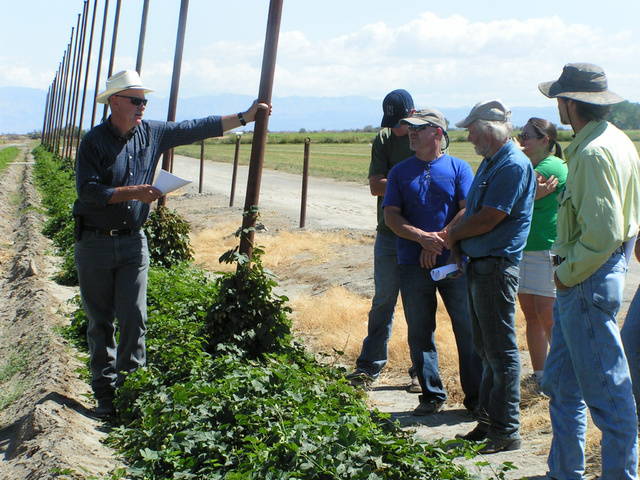Cooperative Extension’s 100 years reflect Nevadans’ ever-new needs

Editor’s Note: Nevada 150 is a yearlong series highlighting the people, places and things that make up the history of the state.
When the University of Nevada Cooperative Extension was founded, agents who represented the southern region had to endure two days of dusty driving — not to mention two nights of camping that could only be considered extremely rustic — to reach offices in Reno. Of course, they probably were used to roughing it, since Las Vegas itself was pretty dusty and rustic, being only nine years in existence.
Today is the 100th anniversary of Cooperative Extension, which came into existence because of the federal Smith-Lever Act in 1914. The purpose was to extend educational opportunities to rural areas, mainly by developing ranch and home projects, a mission those early agents embraced with zeal.
Today? Well, let’s just say some things have changed in the last century, and the University of Nevada Cooperative Extension has worked to keep pace with the times.
“I think the general mission has not changed,” said Karen Hinton, who became the first dean and director when extension became a university college in 1993, and who retired in 2012. “What has changed are the needs of people and society. Cooperative Extension has responded to the needs of people across the state.”
One area reflecting shifting needs, Hinton said, is nutrition, which “has always been a concern.” During the war years, she said, the focus was on the need to grow your own food and preserve food, to cope with shortages. Today, extension educators are dealing with the issue of obesity.
Water is another.
“In Las Vegas many years ago, lack of water was not a problem,” Hinton said. “And now we have a huge horticulture program down there because of the needs of people moving into the valley and wanting to grow things, and using low water for landscaping. There are different issues of home ownership that you didn’t see 50 years ago.”
Dick Post certainly saw that change. Post, who went to work for Nevada Cooperative Extension in 1964 and retired in 2003, started as a horticulture assistant county agent, then moved to the UNR campus and was the state horticulture specialist for 25 years. But in the early years, he may have felt somewhat underappreciated.
“When I first started out in horticulture, at one time the counties were even saying, “You’re not a legitimate job because you’re not working with the farmers; you’re working with people mainly in the city,” he said. “The climate changed. We were working with a broader audience than we had before. It changed from simply a farm and ranch organization to really serving all people of the state.”
And about that “county agent” thing, which brings to mind the old “Green Acres” sitcom and bumbling county agent Hank
Kimball: That went away, too.
“It was just trying to change the perception other people had of us as being the hokey county agent, to educators and teachers,” Post said.
“It’s a little bit different from some states. People in Cooperative Extension at UNR have always been faculty members. In some states, they’re not.”
The old “home economics” fell by the wayside, too, replaced by the more accurate “family and consumer sciences.”
“We got away from the home agent and went to the extension educator,” Post said. “They’d had the homemakers’ clubs around. Those gradually faded away.”
Jackie Reilly, an associate professor emeritus at UNR, who worked for Nevada Cooperative Extension from 1990 to 2013, was in 4-H as a child. Although many people think 4-H is all about working with livestock, Reilly said she concentrated on sewing and leathercraft.
“We did even more than that in the past 25 years,” she said. “There’s so much more that 4-H does. Extension does science, technology, engineering and math — a lot of vocational programs on that. A lot of STEM education is going on in the activities in after-school programs beyond the traditional 4-H club.”
And that after-school programming is another change, she said.
“One of the things that happened when I was there was that the development work went beyond the 4-H clubs and out into the community more,” she said. “In the Reno area, anyway, we were providing after-school programming in the schools before the 21st century came in.”
Post said the mission also changed after the introduction of the F-NET nutrition program.
“What happened was those who were called the home agents all of a sudden found themselves working with low-income families, which they really hadn’t done much of before,” he said.
As the 100th anniversary neared, Hinton said she’s proud of the educational aspects of Nevada Cooperative Extension.
“Cooperative Extension has really been strong in this state, and we’ve had more than the normal share of national award-winners and recognition of the outstanding job that our faculty has done across the state,” she said.
And she sees the mission extending into the next 100 years.
“We constantly assess the needs so that we can keep up with them, but certainly technology is something we continually adapt to, the Internet and being able to respond quickly to people,” Hinton said. “Cooperative Extension became part of a national project called E-Extension that puts information on the Web. We work with people in other states to do this, so people can get information at any time, anywhere.
“These things are important to adapt to. Who knows what the next technology is going to be that we need to format our information for?”
Contact reporter Heidi Knapp Rinella at hrinella@reviewjournal.com or 702-383-0474.